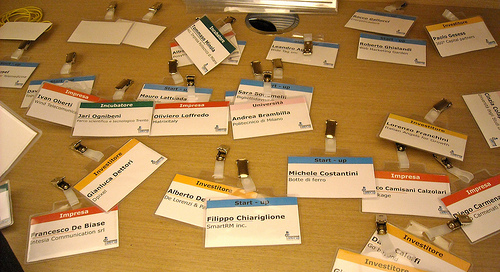|
|
|
Archive for September, 2013
Monday, September 30th, 2013
I find obituaries fascinating and inevitably learn a great deal reading them.
 Although not familiar with Eiji Toyoda, a member of Toyota Motor’s founding family and an architect of its “lean manufacturing,” who died recently at age 100, I am familiar with his results. Although not familiar with Eiji Toyoda, a member of Toyota Motor’s founding family and an architect of its “lean manufacturing,” who died recently at age 100, I am familiar with his results.
In addition to lean manufacturing, he championed the idea for the Prius and, most importantly, the concept of kaizen.
Kaizen is the philosophy that underlies Toyoda’s culture and is responsible for its amazing decades-long growth and success.
…“kaizen,” a commitment to continuous improvements suggested by the workers themselves, and just-in-time production, a tireless effort to eliminate waste. Those ideas became a core part of what came to be called the Toyota Production System and a corporate ethos known as the Toyota Way.
I’ve heard the concept discussed by hundreds of managers over the years and heard many say that it didn’t work when they or their company tried it.
Kaizen reaps only modest success or fails outright in many companies for the same reason that consultants are hired.
Much of American management prefers its solutions and improvements in the form of slickly designed reports and impressive PowerPoint presentations from outside the company and that attitude seems to increase with rank.
Unlike Toyoda and its ilk, where, sans monetary rewards or stock options, workers strive to improve both products and processes.
“One of the features of the Japanese workers is that they use their brains as well as their hands,” Eiji Toyoda said in an interview with the author Masaaki Imai for the 1986 book “Kaizen.” “Our workers provide 1.5 million suggestions a year, and 95 percent of them are put to practical use. There is an almost tangible concern for improvement in the air at Toyota.”
Too often, when US companies invite suggestions from throughout their ranks, they implement only a small number of them and those usually come from “recognized” stars.
That approach/attitude does, however, create jobs by giving rise to an entire industry of high-earning consultants dedicated to teaching management how to “increase employee engagement.”
I wonder if one of the slides is about listening to everyone and then using the ideas.
Image credit: Toyota, 2000GT.net via Japanese Nostalgic Car
Posted in Culture, Personal Growth | No Comments »
Friday, September 27th, 2013
A Friday series exploring Startups and the people who make them go. Read all If the Shoe Fits posts here
 What kind of entrepreneur/person are you? What kind of entrepreneur/person are you?
The kind who posts an “I hate” rant, then edits it and claims it as “humorous satire” when publically taken to task?
The kind who equates a problem like patent trolls to a truly heinous crime like child molesting.
Or the kind who makes your money from an anti-societal app, with essentially (IMO) no redeeming characteristics?
Your legacy probably isn’t of primary concern when most of your life is still to come, but knowing that anything you say or do will exist long after your body has turned to dust should make you think.
Does it?
Image credit: HikingArtist
Posted in If the Shoe Fits | No Comments »
Thursday, September 26th, 2013
 Hey entrepreneurs, you heard it here from a founder a year before another founder said it in Fast Company. Hey entrepreneurs, you heard it here from a founder a year before another founder said it in Fast Company.
“It” is the time you waste at so many of the events dedicated to startups and the personalities that populate the entrepreneurial ecosystem.
Networking is presented as the great equalizer; providing situations that are supposed to bridge the chasm faced by new founders and those with well-connected Rolodexes.
But believing that is in the same league as believing in Santa Clause, the Easter Bunny, the Tooth Fairy or the Silicon Valley Meritocracy.
There is no way to minimize the intensity and energy—mental, physical and psychical—involved in founding and building a company; the most likely result of adding networking to the schedule is faster burnout and more damage to your other relationships.
One of the most important skills a founder (or anyone) needs is the ability to prioritize.
To that end, skip the networking and at least 70% of the time you spend on social media and spend it on high ROI actions, including time with family and friends.
You’ll be glad you did.
Flickr image credit: David Orban
Posted in Entrepreneurs | No Comments »
Wednesday, September 25th, 2013

There is change afoot.
Workers today crave more from work than just a paycheck.
They want to work for, or start, companies that contribute to the greater social good, from encouragement and time to volunteer and sanctioned participation and support in various forms of fundraising to companies who (gasp) give up some profit in the name of “doing good by doing well.”
Candidates and customers flock to companies like Toms Shoes and Warby Parker that guarantee to donate an item for every item sold.
There was a time that companies seemed to give more of a damn about their communities and employees.
Yes it was more paternalistic and I’m not suggesting a return to that, but the enshrinement of greed in the name of profit goes deeper.
What happened?
Milton Friedman, his cronies and a media frenzy happened.
In 1970, Nobel Prize-winning economist Milton Friedman wrote an article in the New York Times Magazine in which he famously argued that the only “social responsibility of business is to increase its profits.”
And as that mantra took hold so did the attitude that the only stakeholders that mattered were shareholders.
The belief that shareholders come first is not codified by statute. Rather, it was introduced by a handful of free-market academics in the 1970s and then picked up by business leaders and the media until it became an oft-repeated mantra in the corporate world.
Which, in turn, entrenched Wall Street’s quarter-long, short-term thinking and gave rise to the Carl Icahns of the investing world.
Friedman’s statement gave tacit approval and wide latitude to corporate raiders, leveraged buy-out firms and others to do literally anything in the name of profit and investor returns.
Lynn Stout, a professor of corporate and business law at Cornell University Law School, said these legal theories appealed to the media — the idea that shareholders were king simplified the confusing debate over the purpose of a corporation.
And we, i.e., society, accepted that attitude for half a century.
The results can be seen every day and they aren’t pretty—unless you’re part of the so-called 1% (or even the top 25%).
While there is change afoot, it begs the question—is it too little too late?
Flickr image credit: 401(K) 2013
Posted in Culture, Innovation | No Comments »
Tuesday, September 24th, 2013

What could Larry Page’s Google possibly have in common with Steve Ballmer’s Microsoft?
Would you believe corporate culture?
Google, long held up an example of great culture is, in fact, as political and siloed as Microsoft.
Not only similar siloed cultures, but a similar approach to changing them.
Ballmer believes that a deeply entrenched culture can be changed by edict and apparently Page does, too.
Page laid down the law: “If you keep fighting, we’ll be very happy to send you to the competition.
“During the speech, one of the executives who was in the room turned to a friend and whispered:“Did he just say, ‘zero tolerance for fighting? I’ve been here for years. All we do is fight.”
If Page is serious about the ‘change or else’ approach you can count on seeing high turnover at Google.
But don’t hold your breath, because words don’t always mean what they say.
Words are interpretive, so people tend to assign their own meanings and put their own spin on what is said.
Says a source who heard the Larry Page sermon at the Carneros Inn: “What he meant by ‘zero tolerance for fighting’ is don’t go overboard.”
This source says there is a “healthy way” to fight at Google.
“The healthy way to fight is to wear two hats.”
“You’ve got to wear your YouTube or Android hat,” the source says. “But the mature executive at Google knows when to put on the Google hat.”
Politics and infighting can only exist if they are openly accepted or covertly tolerated.
As one longtime Google executive put it: “If the princes [are at] war, it’s because the king tolerates it.”
Who knew?
Flickr image credit: mshamma
Posted in Ducks In A Row | No Comments »
Monday, September 23rd, 2013

An article a few days ago made me a happy camper for three very different reasons. Here they are in the order of their importance to me.
Reason 1: It provided a scientifically acceptable reason for having a messy desk and gave me permission to quit trying to clean it up. This was especially nice, since ‘clear desk’ is a constant item on my to-do list.
Reason 2: The clinically tested reason for having a perennially messy desk is creativity. How cool is that?
Reason 3: I beat the pattern because I have creativity, yet I eat healthy and go to the gym daily (not on weekends).
Essentially, the study showed that “Those in messy spaces generated ideas that were significantly more creative, according to two independent judges,… people that are organized and predictable, typically eat better and live longer than people who are disorderly. They also tend to have immaculate offices.
Last year I found that I possessed three of the five parts of Innovator DNA, based on a Harvard definition, but, after a lifetime of trying, am totally incapable of the final two.
Dr. Kathleen D. Vohs, a behavioral scientist at the University of Minnesota and the leader of the study, seems to think that the only way a messy desk person could develop healthy habits is to clean up their desk.
“My advice would be, if you need to think outside the box” for a future project, says, then let the clutter rise and unfetter your imagination. But if your primary goal is to eat well or to go to the gym, pick up around your office first. By doing this, the naturally messy can acquire some of the discipline of the conscientious.
I’m willing to bet that Dr. Vohs is a clean desk person or she would understand that it’s not that simple.
But, as a messy desk person, I will tell you that you can build a healthy eating-gym attending persona without ever cleaning up your desk.
One caveat, in part of the study people were given a choice between chocolate and a healthy snack (carrot sticks?). The messy desk crowd took the chocolate, which meant a messy desk equals unhealthy choices.
However, based on a lifetime of experience with neat desk friends, all with lots of self-discipline, I think it just means they didn’t like chocolate.
Flickr image credit: Jeffrey Beall
Posted in Innovation, Motivation, Personal Growth | No Comments »
Friday, September 20th, 2013
A Friday series exploring Startups and the people who make them go. Read all If the Shoe Fits posts here
 Looking for a great role model? Looking for a great role model?
How about someone who founded his company 38 years ago and is still active in it?
Someone who built an amazing organization, with an incredible track record for success through every economic turn?
A financial innovator who created the first index fund available for individual investors?
Someone Time Magazine named one of the “world’s 100 most powerful and influential people” in 2004 when he was 75.
How about Jack Bogle, who founded and built The Vanguard Group.
“Vanguard now has 14,000 crew members, and it’s big business, and that doesn’t really appeal to me much. But those are the perils and blessings of success. When I get disturbed about all that size – $2.2 trillion is a lot of assets – I remind myself that we’re giving good careers to 14,000 people, and it’s a company that’s value-oriented, service-oriented, integrity-oriented.”
Bogle offers some great wisdom, that, while it is applicable to everyone, is especially apropos for founders.
I pulled what I saw as the most important to share with you, starting with a salient quote by Frederick Buechner that Bogle used in a speech he gave at Princeton.
“To live is to experience all sorts of things. (…) Pay attention to your life.”
You can channel Jack Bogle by taking these five points to heart.
-
“Follow your own instincts, try to be yourself and live your own life. I think there’s a lot of wisdom in that.”
-
“Other than that, it comes down to some pretty simple things: First, don’t forget your family, because in the end, that’s all you really have. Next, be a decent human being, and don’t think you’re better than anybody else, no matter what your condition of wealth or importance.”
-
“Indeed, never forget the important role of luck in your life. Never, never, never, never say, ‘I did it all myself.’ Nobody does it all themselves. And when somebody has the temerity to tell me they did, I say to them: ‘That’s wonderful. I’m not sure I’ve ever met anybody who did it all themselves, but could I ask you one question: How did you arrange to be born in the United States of America?’ “
-
“The struggle is what it’s all about; people ask me about success. Success is a word I almost never use. Success sounds like you’ve achieved something, it’s done.”
-
“But to be corny, though not inaccurate, success is a journey and not a destination. You don’t say, ‘I’ve arrived, I’m here.’ You say, ‘I’ll try to do a little better tomorrow, and all the tomorrows after that.’”
Follow these and you’ll be known not only as a winning founder, but also as an exemplary human being.
Image credit: HikingArtist
Posted in If the Shoe Fits | No Comments »
Thursday, September 19th, 2013

EMANIO CEO and occasional contributor here KG Charles-Harris and I were discussing an article about how being a trouble-maker as a teenager can be predictive behavior to becoming an entrepreneur.
The same urge to innovate, think outside the box, take risks and break rules that helps an entrepreneur later in life might lead them to more destructive behavior as a teenager.
But only the guys.
However, the association only held up in the case of male entrepreneurs. Female entrepreneurship could not be predicted by moderately anti-social teenage behavior.
And those guys were well-off and white.
People coming from families that were comparatively well off in 1979, where the parents had some level of higher education, and where they lived in a two-parent home through age 14 or so, were more likely to be entrepreneurs.
Essentially the whole thing says what we all know, but rarely admit.
Affluent, white, male troublemakers are more likely to become entrepreneurs.
Their families have enough pull and resources to prevent them from being labeled ‘difficult’, let alone ‘delinquent’, because once you label a person and they are treated by society according to that label they often end up believing the label themselves…whatever it is.
And that label often becomes self-fulfilling prophesy.
Are you really surprised that when a middle or upper-class boy acts out the long-term result will be substantially different than when a black, inner city boy does the same thing?
Professionally, managers often do the same thing when they treat their people based on their title—then wonder why they don’t fulfill their promise.
Flickr image credit: SiSter PhotograPher
Posted in Entrepreneurs | No Comments »
Wednesday, September 18th, 2013
 When I lived in San Francisco I always found it a point of hilarity that the those in tech assumed that everybody everywhere were as tech-centric as they were and I know from friends that that attitude hasn’t changed. When I lived in San Francisco I always found it a point of hilarity that the those in tech assumed that everybody everywhere were as tech-centric as they were and I know from friends that that attitude hasn’t changed.
It was/is also a given that innovation is hottest in the Bay Area/Silicon Valley closely followed by places like Silicon Alley in New York City and similar areas around the world.
And the greatest myth of all is that innovation is hottest in startups; especially those started in a college dorm.
Large public companies must innovate or lose the faith of their investors and the tech-centric world always points with pride to giants like Google, Apple and Amazon as innovation leaders.
But are they?
Not according to Hal Gregersen, Senior Affiliate Professor of Leadership and Innovation at INSEAD, and Jeff Dyer, Professor of Strategy at Brigham Young University, co-authors (with Clayton Christensen at Harvard Business School) of the bestseller The Innovator’s DNA.
To compile the list, we use what we call the “Innovation Premium,” which is calculated by:
- Projecting a company’s income as expressed in cash flows from existing businesses;
- Determining anticipated growth from those businesses;
- Comparing the net present value (NPV) of those cash flows with the firm’s current market capitalisation.
We require at least seven years of financial data – a feature that for the moment excludes companies such as Facebook Inc. – and only consider firms with a market value greater than $10 billion. We also use a “research and development” screen, which requires qualified companies to make some investment in R&D.
Using those criteria to compile a list of the 100 Most Innovative Companies, Google is number 47, while Apple is in 79th place, both well below number 30 P&G; Amazon is number seven and Salesforce.com is first for the third year in a row.
Facebook hasn’t been around long enough to qualify and there’s no telling if it will be.
Our list illustrates investors’ appreciation of these companies’ potential as innovators for the long term.
That’s the same reason VCs and angels invest in startups for the short term.
Image credit: Insead
Posted in Innovation | No Comments »
Tuesday, September 17th, 2013

Discussion on company culture usually center on what a company does with regards to its people focusing primarily on perks and attitudes.
There’s recognition that in addition to the corporate culture there are dozens of subcultures, since every manager, no matter what level, shapes/tweaks the culture for her subordinates.
If managers want to hire successfully they need to understand that culture is a direct result of MAP (mindset, attitude, philosophy™) and no two people’s MAP is identical.
Simply put, culture is the ‘what’, while MAP is the ‘why’.
It’s relatively easy to know the ‘whats’ of your culture.
Understanding the ‘why’ takes more effort.
But if you don’t understand your MAP, the ‘why’ of your and your company’s actions, there is every chance that you’ll have great difficulty implementing the kind of culture that’s attracts and retains great talent.
That’s because the ‘what’ needs to be, at the very least, synergistic with the ‘why’, whether it’s your MAP or the candidates, otherwise performance and creativity will suffer.
Knowing your MAP is like knowing what size clothes you wear—it keeps you from hiring people who would have little chance to succeed in the environment you provide.
Flickr image credit: lennox_mcdough
Posted in Culture, Ducks In A Row | No Comments »
|
 Subscribe to
Subscribe to
MAPping Company Success
About Miki 
Clarify your exec summary, website, etc.
Have a quick question or just want to chat? Feel free to write or call me at 360.335.8054
The 12 Ingredients of a Fillable Req
CheatSheet for InterviewERS
CheatSheet for InterviewEEs™
Give your mind a rest. Here are 4 quick ways to get rid of kinks, break a logjam or juice your creativity!
Creative mousing
Bubblewrap!
Animal innovation
Brain teaser
The latest disaster is here at home; donate to the East Coast recovery efforts now!
Text REDCROSS to 90999 to make a $10 donation or call 00.733.2767. $10 really really does make a difference and you'll never miss it.
And always donate what you can whenever you can
The following accept cash and in-kind donations: Doctors Without Borders, UNICEF, Red Cross, World Food Program, Save the Children
*/
?>About Miki
About KG
Clarify your exec summary, website, marketing collateral, etc.
Have a question or just want to chat @ no cost? Feel free to write
Download useful assistance now.
Entrepreneurs face difficulties that are hard for most people to imagine, let alone understand. You can find anonymous help and connections that do understand at 7 cups of tea.
Crises never end.
$10 really does make a difference and you’ll never miss it,
while $10 a month has exponential power.
Always donate what you can whenever you can.
The following accept cash and in-kind donations:
|
 Although not familiar with Eiji Toyoda, a member of Toyota Motor’s founding family and an architect of its “lean manufacturing,” who died recently at age 100, I am familiar with his results.
Although not familiar with Eiji Toyoda, a member of Toyota Motor’s founding family and an architect of its “lean manufacturing,” who died recently at age 100, I am familiar with his results.



 What kind of entrepreneur/person are you?
What kind of entrepreneur/person are you?







